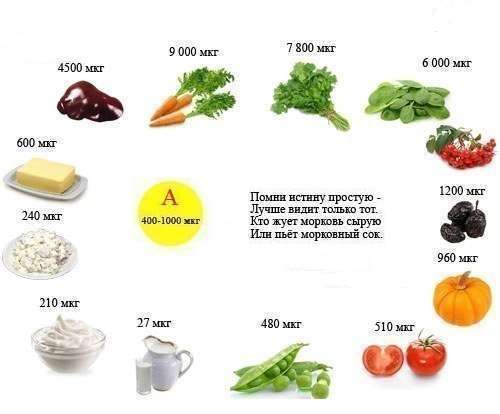Vitamins A groups collect substances with similar biological effects. They include retinal(aldehyde - vitamin A), retinol(alcohol - vitamin A), retinoic acid(acid - vitamin A). In its pure form, it was isolated by Mendel and Osborne from butter. Scientists have discovered this vitamin in fish oil, full-fat milk, cream, butter and full-fat cottage cheese, egg yolks, cheese, liver, heart and brain. The amount of vitamin in products of animal origin directly depends on the type and composition of food that the animal itself consumes. Therefore, fish oil is 100 times richer in retinol than, for example, butter, because the plant plankton that fish eat is precisely saturated with vitamin A.
Effect of vitamin A
Vitamin A guarantees the integrity of the cells responsible for the formation of mucous membranes and skin, and it also accelerates the healing process of the skin in case of damage. Composition of many cosmetics contains its analogs that have a beneficial effect on the skin.
Both vitamin A and -carotene, being strong antioxidants, are means for treatment and prevention cancer diseases .
Daily value of vitamin A
Vitamin A (retinol) has the ability to accumulate in the liver. With very long use of retinol in increased doses, it begins to become toxic to the body. The daily dosage of vitamin A is different for absolutely all age groups and gender groups of people. Men need to get 650-950 mcg of vitamin A per day, and women 600-800 mcg, but for pregnant women daily requirement in vitamin A increases by 100 mcg, and for nursing mothers - by 410 mcg of this vitamin. The children's required daily dose of retinol is in the range of 400-1000 mcg. In case of acute deficiency, the dosage is increased to a maximum of 3000 mcg. Vitamin A is best absorbed with fatty foods. It is important to consider that when processing and cooking food, 10-40% of retinol is lost. We must remember this when preparing food rich in vitamin A.
Vitamin A deficiency
Lack of vitamin A leads to “night blindness” - this is the very first and most important sign indicating its deficiency. How can it be detected? You just need to leave a well-lit room and go into a dark one. If at the same time your eyes adjust to darkness for more than 8-9 seconds, you may not have enough vitamin A; if it takes more than 15-25 seconds, then you need to see a doctor! If it only takes a few seconds for you to do this, then everything is fine and your body has the normal level of vitamin A.

In China and Ancient Egypt“Night blindness” was cured by dishes prepared from half-raw liver. Liver juice is the most generous source of vitamin A. This complex compound comes in a number of forms. But two of them are significant for us: vitamin A, which is obtained from animal sources, carotene, and retinol, obtained from plant sources.
A lack of vitamin A in the human body is also indicated by a burning sensation under the eyelids, pain in the eyes from bright light, and “goose bumps” on the hips and elbows. In children, this is a delay in development and growth.
One of the initial signs of insufficient vitamin A in the human body is tightness and dryness of the skin. Accordingly, any diseases of the skin structures indicate that our diet must certainly include foods enriched with vitamin A.
What are diseases of the skin structures? This is atrophy of the sweat glands, dryness of the mucous membranes: the oral cavity, paranasal sinuses, nostrils, trachea, bronchi, i.e. diseases associated with disorders of the respiratory tract, - all this is directly related to the amount of vitamin A in the body. One has only to increase the dosage of this vitamin and all problems will be eliminated. Even psoriasis, in some cases, can be cured by increasing the dosage of vitamin A.
Indications for the use of vitamin A:

A popular component of anti-aging creams and one of the usual reasons to purchase fish oil is vitamin A.
It received its letter designation for being the first vitamin discovered.
Back in 1913, it was described by two independent groups of scientists.
This vitamin also has other names: trans-9,13-Dimethyl-7-(1,1,5-
trimethylcyclohexen-5-yl-6)-nonatetraen-7,9,11,13-ol and more familiar to our ears - retinol.
As it turns out?
This fat-soluble vitamin is not found in nature in its pure form. And in food a person can get two of it different ways. The simplest is from animal products, where retinol is contained in a form ready for absorption.
More complex - from plants containing red vegetable dyes carotenoids, which are converted in the body into vitamin A. They got their name thanks to the English name for carrots - carrot - from which they were first isolated.
The most famous carotenoid that supplies the body greatest number vitamin A – beta carotene- turns into it as a result of splitting in the liver. Carotenoids can be found not only in plants - they are found in algae and even mushrooms.
Why is it needed?
The best known role of vitamin A is to provide good vision. It helps synthesize the retinal visual pigment rhodopsin, which helps capture even the weakest light and is responsible for night vision.
Retinol is also involved in the secretion of tear fluid, which protects the cornea from drying out. And the carotenoids lutein and zeaxanthin reduce the risk of developing cataracts and slow down the processes of degeneration in the visual apparatus.
Men may notice a deficiency of this vitamin in the form of weakening erection and premature ejaculation. Frequent respiratory diseases and a serious decrease in work ability are also signs of vitamin A deficiency.
What prevents it from being absorbed?
Since vitamin A is fat-soluble, an insufficient amount of fat in the diet, for example, with a strict unbalanced diet, seriously impairs its absorption by the body.
For those who are engaged in weight loss using biological active additives, you should carefully read their composition. If they contain mineral oils, used as laxatives - Vaseline or castor - they can dissolve vitamin A and remove it from the body.
Vitamin A is poorly absorbed in those who abuse alcohol and smoke - due to disruption of the liver, which promotes the absorption and storage of retinol.
The absorption of vitamin A and the deficiency of its “partner” - vitamin E - and zinc impairs.
What to eat?
Most retinol is found in fish oil and beef liver. There is enough of it in dairy products - milk, cream, butter and cheeses, as well as chicken eggs.
Almost all bright yellow and red vegetables and fruits, as well as dark green leafy crops such as spinach, broccoli or green onions, are rich in carotenoids. There are carotenoids in legumes.
Together with fats, beta-carotene is absorbed 30 percent better. But only if it enters the body on an empty stomach, so this is not a reason to consume excess fat. For normal absorption of beta-carotene, the fats that a person receives during the day from food are sufficient.
The most important
Vitamin A is necessary for good vision, immunity and beautiful skin and hair. You can get it in two ways - from animal products and plant foods, which contain it in the form of provitamin A.
Vitamin A (retinol) was one of the first to be discovered. It is urgently needed to the human body to maintain good vision, active work immune system and to maintain skin health. It is a fat-soluble substance that accumulates in the liver. Our body mainly gets retinol from foods rich in animal fats and carotenoids (in particular, beta-carotene). Vitamin A is now available in many dosage forms, including pills, capsules, film-coated tablets, oral drops, intramuscular oil solution, oral solution and topical solution. But do not forget that vitamin A is found in sufficient quantities in food.
Vitamin A is often found in foods in sufficient amounts large quantities, “champions” in this regard are considered:
- liver;
- fish oil extracted from cod liver.
- egg yolk;
- butter;
- beef;
- full fat milk and cream.
Many dark green, orange, yellow and red vegetables and fruits also contain retinol.
You should know that a person’s daily need for retinol is 2300-3000 IU.
Application in medicine
Due to the versatile properties of this vitamin, it is often used to treat many skin diseases, various eye diseases and various infections.
The beneficial effects of retinol on the human body are truly difficult to overestimate. We list its main useful properties:
- is an effective preventative against night blindness, helps the eyes adapt to sudden changes in lighting brightness, and also protects the mucous membranes of the eye from excessive dryness;
- actively affects skin cells, preserving them and supporting their normal functioning$
- takes part in the formation of immune cells, thereby strengthening the body's protective functions.
- involved in the formation of bones and teeth.
- necessary for normal development and growth of the body, as well as for reproduction.
Due to the presence of such useful properties Vitamin A is actively used in medicine.
Retinol is often used to strengthen the immune system for various infectious diseases(for sore throat, bronchitis, flu). Effective for herpes, warts and shingles, as well as allergic reactions. As an auxiliary drug, vitamin A is used in the treatment of breast cancer, lung cancer, and leukemia. It is also believed that retinol can increase the effectiveness of chemotherapy used to treat cancer patients.
Retinol is actively used in the treatment of various skin diseases, caused, in particular, by vitamin A deficiency, to treat dry skin, acne, psoriasis, and eczema. It promotes more fast healing wounds and is used for burns, cuts and abrasions. It has been noted that the use of vitamin A contributes to a faster recovery of patients after joint dislocations and muscle and tendon strains.
Application for hair
With a lack of this vitamin in the body, hair becomes dry, brittle and faded, and dandruff appears. Of course, it is advisable to establish proper diet nutrition, including products containing this valuable substance. You can also use solutions, capsules and tablets containing retinol. Using masks containing vitamin A for hair is very effective. These masks will not only restore healthy appearance hair, but will also contribute to its rapid growth.
Indications for use
As you know, an excess of nutrients is just as undesirable as their deficiency. Therefore, you can take medications containing retinol only for special indications. The use of vitamin A is indicated in the following cases:
- retinol deficiency;
- diseases of the mucous membranes;
- separate skin diseases and skin damage;
- eye diseases (in particular conjunctivitis, keratitis);
- to accelerate tissue restoration and healing processes after operations;
- for acute and chronic diseases of the bile ducts (as part of complex therapy);
- infectious diseases (as part of complex therapy).
In addition, women who have heavy menstrual bleeding should take vitamin A.
For preventive purposes, the drug is taken 10-15 minutes after eating.
To treat severe painful conditions, vitamin A in the form of an oil solution is administered intramuscularly, after preheating the solution. With long-term use, courses of intramuscular injections should be alternated with oral administration of capsules and tablets.
For mild and moderate vitamin deficiency, adult patients are prescribed 33 thousand IU of retinol per day.
For xerophthalmia and hemeralopia, 50-100 thousand IU of retinol per day is prescribed for the treatment of adult patients, and for the treatment of children - 1-5 thousand IU per day.
3.71 out of 5 (7 Votes)
